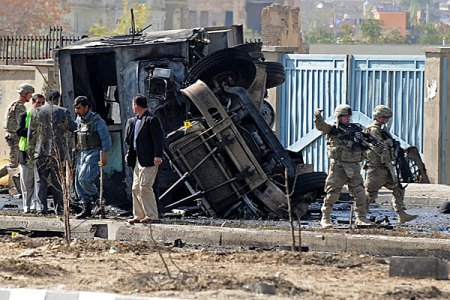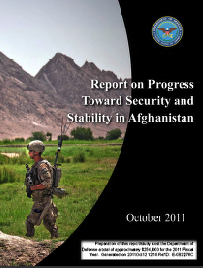
Afghanistan's security force and rescue personnel and NATO troops inspect the site of a suicide attack near the Darul Aman palace in Kabul on October 29, 2011. (Massoud Hossaini / AFP / Getty Images)
A Taliban suicide bomber killed 12 Americans — four troops and eight contract workers — four Afghans, and a Canadian soldier, when he rammed his bomb-laden Toyota into an armored bus in Kabul Saturday. The brazen attack marked the deadliest strike against Americans in the Afghan capital since the U.S. invaded 10 years ago this month.
Abdul Rahman Hazarbos set off 1,500 pounds of explosives as he drove his sedan into the bus on a main road regularly used by NATO trainers between their posts and a major Afghan training center, the Taliban claimed.
The attack succeeded despite the fact that the the U.S. bus – apparently an armored RhinoRunner, typically a 13-ton vehicle described by its builder as “The Toughest Bus on Planet Earth” — was traveling the four-lane highly amid an armada of Mine-Resistant Ambushed Protected vehicles. Four Afghans – three civilians and a police officer – also died in the blast, which flipped the vehicle on its side, a U.S. official said.
Defense Secretary Leon Panetta was told of the convoy attack shortly after it happened. “His heart goes out to those who were killed and wounded, and to their families,” Pentagon Press Secretary George Little said. “Continuing our aggressive pursuit of the enemy will honor their sacrifice, and he is determined that the United States, working closely with our Afghan and NATO partners, will do precisely that.”
The blast marked the biggest U.S. death toll in Afghanistan since August 6, when the Taliban downed a helicopter, killing 38 – including 30 Americans, among them 17 Navy SEALs.
More important than the death toll, however, is the fact that this is the latest attack in the heart of Kabul, the nation’s capital. Afghan President Hamid Karzai has been dismissed by some for years as merely “the mayor of Kabul,” but U.S. officials continue to be distressed over the Taliban’s ability to strike inside the city.
“Over the past decade, significant advances have been made across Afghanistan,” Army Lieut. General Curtis Scaparrotti, the No. 2 U.S. officer in the country, told Pentagon reporters Thursday in a briefing piped in from Kabul. “Our strategy is now focused, the coalition is strong, our Afghan partners are fully engaged, and we have the momentum, resources and resolve to succeed.”

Latest semi-annual report
Last week, the Pentagon sent Congress its required semi-annual assessment that said a “firm foundation” exists to shift responsibility for defending the country from foreign to Afghan troops. “After five consecutive years where enemy-initiated attacks and overall violence increased sharply each year (example, up 88 percent in 2010 over 2009),” the report noted, “such attacks began to decrease in May 2011 compared to the previous year and continue to decline.”
The explosion caused the largest loss of life in a string of attacks Saturday. An Afghan soldier shot and killed three NATO troops in Kandahar, while gunmen in Khost killed four NATO supply-vehicle drivers.
In Saturday’s lone bit of good news, a burqa-clad female attacker was killed as she approached a government building in Kunar province. Alerted to the possibility of such an attack, Afghan guards fired on her as she drew close to the building, forcing her to detonate her explosives some distance away. Four people were wounded.


